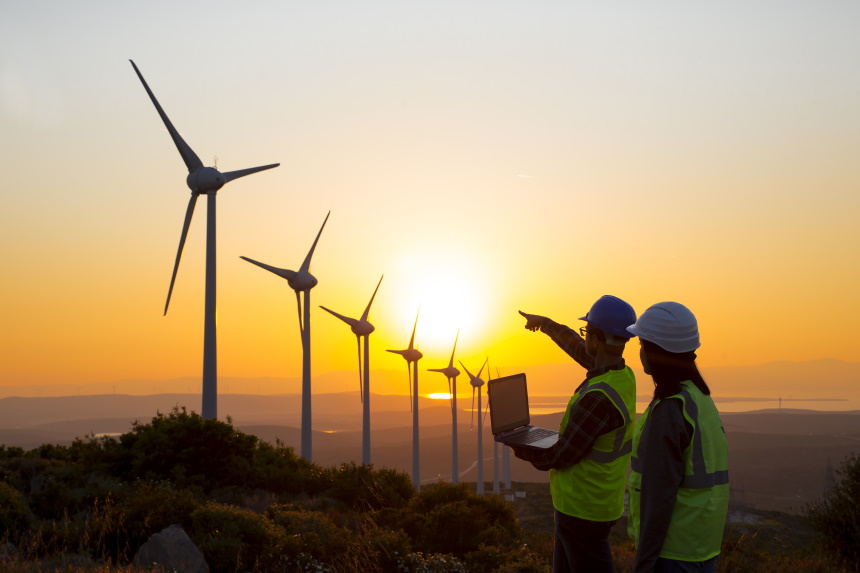
73% of millennials are willing to do business with companies that follow eco-conscious practices.
By implementing technology within your company that benefits the health of our planet, you can make your business appealing to a growing consumer base – and make a difference.
In this article, we will discuss five technologies that help the environment and walk you through the positive impact they have on our communities.
We’ll also explain how doForms benefits the environment – as well as your business.
Discover our mobile forms features.
Try doForms for free!
Table of Contents
Technologies That Help The Environment: 3 Key Benefits
Recent technological breakthroughs have made it possible for communities to tackle longstanding environmental issues.
Here are three of the most positive impacts of new technology on our planet’s wellbeing.
Conservation Of Resources
Internet of Things (IoT) devices and smart household appliances can alert users about excessive energy waste and use AI to turn off the power when they are not in use.
For example, smart bulbs and thermostats can automatically detect activity in the room and turn off the light when there’s nobody around, to help preserve energy.
A smart sprinkler system is able to adjust itself according to the weather and it regulates water consumption levels, optimizing its impact on the water supply and reducing water bills.
Modern green buildings utilize natural light to reduce the coal consumption required to power them, which also results in lower lighting bills.
In 2017, electric power accounted for 93% of coal consumption in the US. As a result of the implementation of smart technologies, the power sector in the US consumed 30% less coal in the first half of 2020 than in the same period in 2019.
Waste Elimination
Fast and easily shareable data collection technology helps prevent the waste of the world’s resources. For example:
- It can put a stop to food waste by keeping track of it across the entire cycle, from production to distribution and supply to consumption.
- This technology is also a much-needed alternative to printed materials responsible for deforestation and paper-based waste.
- Faster internet and streamed media reduce the need for producing CDs and DVDs, including their wasteful packaging.
Inventive breakthroughs in biofuels and digesters are also finding new energy sources in excess food and other surplus products.
Less waste in all facets of the industry and daily life leads to more sustainable practices all around.
Improvement Of Our Health And Cognitive Abilities
Devices we use on a daily basis and our immediate surroundings are already equipped with technology that improve our own functioning. For example:
- Health and fitness apps help users preserve mental and physical wellness by reminding them to exercise, drink more water and eat healthier. The introduction of AI in medicine can lead to quicker health diagnoses and the accuracy of treatment suggestions.
- Smart home systems that change or shut down light at certain times contribute to better sleep patterns and protected eyesight.
- Today’s smart classrooms stimulate students’ active participation and interaction with personal digital devices, smart whiteboards and smart projectors. Smart classrooms also conserve energy and include AI-based climate control and lighting to create a comfortable learning environment that improves alertness and responsiveness.
- Workplace technology like digital work management systems help us work smarter and more efficiently by improving processes and workflows, analyzing data and identifying problems faster than humans.
Healthier and more alert people have a better capacity to work, learn and think smarter, leading to more ways of preserving the environment.
5 Sustainable Technologies And How They Affect The Environment
The following technological innovations introduce a major leap towards a sustainable future, waste elimination and the reduction of energy consumption.
1. Carbon Capture And Storage
Carbon capture and storage (CCS) is an emerging technology that separates the carbon dioxide – a gas with a presence in Earth’s atmosphere that is warming our planet – from other gases that industrial processes generate.
It does so via post-combustion capture, pre-combustion capture and oxyfuel combustion methods. CCS transports carbon by pipelines and stores it in rock formations underground where it does not inflict any damage on the environment.
The first carbon capture facility in the world was opened in Switzerland in 2017. Companies in the US and Canada are also developing their own carbon capture plants that could reverse one of the most damaging environmental trends and lead to the improvement of our planet’s health.
2. Solar Glass
Solar glass is another emerging technology that may greatly improve global energy sustainability.
It is a material used for making windows and other glass surfaces that capture the energy of the Sun and convert it into electricity.
A scientific team at the University of Michigan developed a solar glass that generates an efficiency of 15% or more, while also letting 50% of light pass through the window. This solves one of the biggest solar glass hurdles — maintaining window transparency without sacrificing the efficiency of converting light into electricity.
According to the team’s estimate, there is currently enough usable window space to supply 40% of US energy needs with solar glass.
3. Smart Grids
The grid — the current power production infrastructure — is mainly centralized and very responsive to usage fluctuations. It requires a massive production of energy to work dependably, which often causes overproduction and energy waste. The grid also relies heavily on energy sources that emit pollution.
Smart grids that deploy multiple energy distribution, automation, networking and sensor technologies are currently being tested around the developed world. They will enable a very localized energy production — even down to individual households — that can be sent back to the grid.
Thanks to sensor technology and highly precise prediction algorithms, the production of energy can be fine-tuned to evade overproduction and waste. Improved battery technology will lead to efficient storage of energy from renewable sources.
A study by Electric Power Research suggests that smart grid technology may reduce carbon emissions by 58% in 2030, compared to 2020 levels.
4. Environmental Sensors
Networked sensors monitor the quality of air and water, keep track of acidification, identify sources of pollution and capture real-time data on other environmental factors that compromise the health of our planet.
Sensor technology has advanced by leaps and bounds in recent years. Localized sensor networks keep track of energy and water usage to reduce waste, while air pollution trackers warn the public about levels of harmful elements in the atmosphere.
The next breakthrough in environmental sensor technology is a wearable air quality sensor that will enable individuals to measure the levels of pollution in a city.
5. LED Lighting
Energy-efficient LED lighting technology is already replacing traditional bulbs in many homes and public spaces.
It consumes much less power per unit of light emitted compared to iridescent bulbs, cutting down greenhouse emissions from power plants. Also, LEDs do not contain any hazardous materials and their carbon emissions are low.
By 2030, LED bulbs will account for an 84% market share in the US. In the same year, this technology will reduce the consumption of energy by 40%, approximately saving about $26 billion in today’s energy bills.
doForms’ Role In The Promising Effect Of Technology On The Environment
The paper industry is the third biggest land, air and water polluter in the US, with more than 100 million kg of toxic waste produced each year.
Deforestation – the first step in creating paper – leads to 18 million acres of forest lost every year, which contributes to 15% of annual global greenhouse gas emissions.
In addition, for every ton of paper produced, over 1.5 tons of carbon dioxide is released into the atmosphere.
doForms electronic mobile forms digitize your data management, collection and storage, effectively reducing or even eliminating paper use.
By providing you with eForms you can even use offline, doForms contributes to a reduced carbon footprint, the lowering of greenhouse gas emissions and the preservation of trees and forests.
On average, using doForms replaces 80,500 pieces of paper per year and saves one tree.
The solution’s on-site data collection capabilities eliminate the need for trips to the office for paper filing and updating purposes.
In doing so, doForms cuts down carbon emissions by over 1.6 million grams and saves you money in the process!
Going beyond eliminating paper, doForms also improves service quality an ensures properly completed and delivered forms and documents, as well as consistently managed records.
By going paperless with doForms, you can:
- Reduce paper use for environmentally friendly and sustainable business
- Cut down costs associated with paper, printers, copiers, cartridges and ink
- Appeal to a rising demographic much more concerned about the environment than previous generations
- Save office space by eliminating filing cabinets
- Boost productivity and efficiency by removing time lost searching for documents
- Introduce faster business flow through electronic signatures and remote file transfer
- Backup all of your documents safely on a cloud service
- Get real-time updates on the delivery of your documents and completion of tasks
Watch the video below to find out more about the paperless end-to-end business capabilities of doForms.
The Positive Impact Of Technology On The Environment: Real-Life Examples
For JLL, using doForms helped the company streamline its work order communications. But this also came with a very tangible “green” benefit.
doForms’ customizable digital form helped the business replace 80-page paper surveys with an electronic solution that doesn’t produce waste and cause pollution when multiplied, stored or discarded.
Let’s look at a few other real-life examples of technology’s beneficial impact on the environment.
In 2012, volunteers in New York City roamed the city taking measurements at the street level. They followed a usual route a typical NYC adult takes every day.
The results showed that 1% of the city’s buildings were emitting more pollutants than all the city’s cars combined! They launched a program called Clean Heat in cooperation with the city’s ex-Mayor Bloomberg. Backed by private funding, they helped 6,000 buildings upgrade to cleaner fuel.
In 2016, the World Wildlife Fund (WWF) teamed up with Apple to start the Apps for Earth campaign that raised $8 million and educated millions of people about nature conservation issues.
A few years later, a new campaign called WWF Free Rivers used Apple’s augmented reality technology to educate people on the importance of free-flowing rivers. Intel and WWF also teamed up in China and used the power of AI to protect wild tigers’ habitats and numerous other species.
In 2017, the entire United Kingdom ran without coal power for three days between April 21st and 24th for the first time since the 19th century, when coal was first used as a source of energy. The country’s electricity was supplied by gas, windfarms, biomass, solar and nuclear power – all cleaner sources of energy than coal.
Technologies That Help The Environment: Key Takeaways
Mobile forms help reduce carbon and greenhouse gas emission by cutting down paper and eliminating unnecessary trips to the office.
Companies that adopt electronic forms and go paperless not only save money and improve their processes, but also contribute to the environment’s health and wellbeing.
Our paperless forms streamline and accelerate your daily work processes by collecting and organizing data efficiently, while keeping the costs down.
doForms’ major benefits include:
- Real-time functionality
- Versatility
- Cost-effectiveness
- Customization
- Data security
- Accessibility




